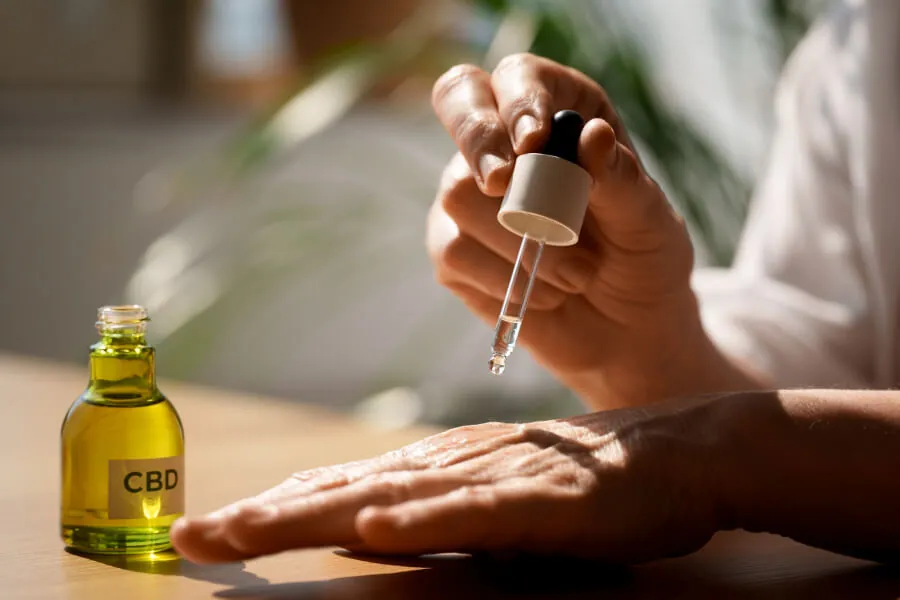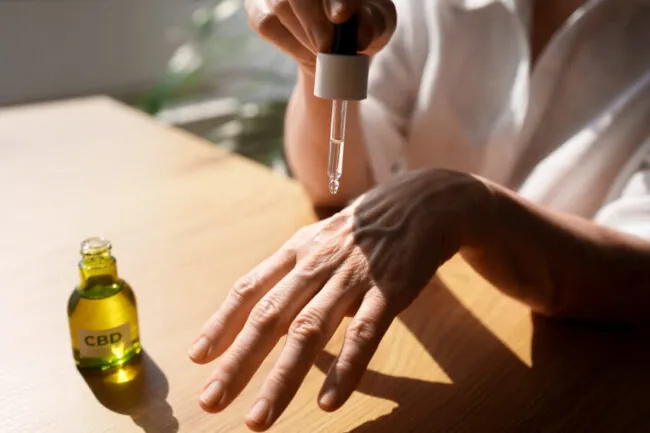Have you ever wondered how CBD, when applied to your skin, works its magic? You’re in the right place!
Discover the fascinating world of CBD absorption through the skin and explore the three key factors that make it all happen.
The Science Behind CBD Absorption Through the Skin
Overview of CBD
First, a quick primer: CBD is a natural compound found in cannabis plants. Unlike its cousin THC (tetrahydrocannabinol), CBD doesn’t get you high. Instead, it has therapeutic effects, from reducing anxiety to reducing your pain. But how does CBD interact with our bodies, especially through our skin?
The Skin’s Role in Absorption
Our skin is not just a protective barrier; it’s an active organ capable of absorbing substances. When it comes to CBD, the skin’s layers play an important role. CBD must penetrate the outer layer (epidermis) and reach the middle layer (dermis) where blood vessels are located. However, this journey is not as straightforward as it seems.
The Endocannabinoid System and CBD
Enter the endocannabinoid system (ECS) – a complex cell-signaling system in our body. The ECS plays a role in regulating various functions like sleep, mood, pain, and immune response. It consists of endocannabinoids, receptors, and enzymes. CBD interacts with the ECS, particularly the receptors in the skin, to produce its effects. But the extent of this interaction depends on different factors.
Topical Application of CBD
Types of CBD Products for Topical Use
CBD-infused topicals come in various forms
- CBD Creams
- CBD Balms
- CBD Lotions
- CBD Salves
- Transdermal patches
Each product type has unique properties affecting CBD Absorption through the skin.
For example, creams and lotions are often water-based, making them less greasy and easier to spread. On the other hand, balms and salves are thicker and oil-based, providing a more prolonged application.
Mechanism of Action for Topical CBD
When you apply a CBD product to your skin, it doesn’t enter your bloodstream directly. Instead, it interacts with nearby cannabinoid receptors.
This interaction can help manage localized pain and inflammation. Think of it like a lock and key mechanism where CBD (the key) fits into the ECS receptors (the lock) to unlock therapeutic benefits.
Difference between Regular topicals and Transdermal CBD patches
Regular topicals just go on your skin, while transdermal CBD patches are designed to deliver CBD through your skin and into your bloodstream. This method offers a controlled release over time, making it a preferred choice for consistent CBD delivery. But to get the CBD into your bloodstream, you have to get past your skin’s natural barrier, which is where formulation science comes into play.
Factors Affecting CBD Absorption Through the Skin
Now, let’s get to the heart of the matter. Three primary factors influence how well CBD is absorbed through the skin:
Formulation and Concentration of CBD Products
The composition of a CBD product significantly impacts its absorption. Products with higher CBD concentrations tend to be more effective. Moreover, the presence of lipids (fats) in the formulation can enhance CBD’s ability to penetrate the skin. Lipids facilitate the movement of CBD through the skin’s layers, ensuring it reaches the desired depth.
Skin Integrity and Permeability
Your skin’s condition also affects CBD absorption through the skin. Healthy, intact skin has a robust barrier function, which can limit CBD’s penetration. Conversely, damaged or inflamed skin may allow for better absorption. This is why people with skin conditions like eczema might experience different results compared to those with healthy skin.
Presence of Enhancers or Permeation Agents
Some ingredients, called permeation boosters, can help the body absorb more CBD. These agents temporarily change the skin’s barrier properties, allowing CBD to pass through more easily. Common boosters include essential oils (like peppermint or eucalyptus), ethanol, and carrier oils such as coconut or olive oil.
Impact of Skin Type on Absorption Efficiency
Your skin type can also play a role in how well CBD is absorbed. Oily skin may absorb oil-based products more effectively, while dry skin might benefit from water-based formulations. Additionally, factors like age, thickness, and hydration level of your skin can influence absorption rates.
Benefits of Topical CBD
So, what can you expect from using CBD topically? Here are some benefits that have made CBD a popular choice for skin applications:
Localized Pain and Inflammation Relief
One of the most common uses of topical CBD is for pain and inflammation relief. Whether it’s joint pain, muscle soreness, or skin irritation, CBD can provide targeted relief without the need for systemic medication.
Management of Skin Conditions like Eczema and Acne
CBD’s anti-inflammatory and antimicrobial properties make it a promising option for managing skin conditions such as eczema and acne. It can help soothe irritation, reduce redness, and prevent the spread of bacteria.
Skincare and Beauty Applications
CBD is also making waves in the beauty industry. Its antioxidant properties can help protect the skin from damage caused by free radicals, promoting a youthful and healthy appearance. CBD-infused skincare products are popular for their potential to hydrate, nourish, and improve overall skin texture.
Relaxation and Stress Relief Properties
Beyond physical benefits, topical CBD can also contribute to mental well-being. The soothing effects of CBD can help alleviate stress and promote relaxation when used in massages or self-care routines.
Safety Considerations for CBD Skincare Products
While the benefits of CBD are compelling, it’s important to consider safety aspects:
THC Content and Legal Compliance
Ensure that your CBD product complies with local laws regarding THC content. In many places, CBD products must contain less than 0.3% THC to be legally sold. Always check the product label and opt for reputable brands that provide third-party lab testing results.
Quality and Purity Standards
Choose products that adhere to high-quality standards. Look for organic, non-GMO, and pesticide-free labels. Quality products are less likely to contain harmful contaminants that could cause adverse reactions.
Addressing Allergies and Skin Sensitivities
If you have sensitive skin or allergies, perform a patch test before using a new CBD product. Apply a small amount to a discreet area and wait 24 hours to see if any reaction occurs. If irritation develops, discontinue use immediately.
Potential Interactions with Other Medications
Consult with a healthcare professional if you are using other medications or have underlying health conditions. While topical CBD is generally considered safe, interactions with other treatments can occur.
How to get Maximum CBD Absorption Through the Skin?
To get the most out of your CBD topicals, follow these tips:
Optimal Application Techniques
Apply CBD products to clean, dry skin. Massage the product thoroughly to enhance CBD absorption through the skin and stimulate blood flow. Using a circular motion can help distribute the product evenly and ensure better penetration.
Choosing the Right CBD Product for Skin Type
Select products tailored to your skin type and needs. For dry skin, opt for moisturizing formulations with added hydrating ingredients. If you have oily or acne-prone skin, look for lightweight, non-comedogenic options.
Consistency in Usage for Desired Effects
Consistency is key to experiencing the full benefits of CBD. Incorporate CBD topicals into your daily routine and give your skin time to respond. It might take a few applications before you notice significant changes.
Conclusion
Understanding CBD absorption through the skin through the skin can enhance your experience and maximize its benefits. Remember, the formulation and concentration of the product, your skin’s condition, and the presence of enhancers are crucial factors.
Research on CBD absorption through the skin is ongoing, and future advancements may bring even more effective and targeted topical products. Stay informed and keep exploring new developments in this exciting field.
FAQs
What Is CBD?
CBD, or cannabidiol, is a natural compound found in cannabis plants known for its potential therapeutic effects without the psychoactive properties of THC.
How do I take CBD?
CBD absorption through the skin can be taken in various forms, including oils, capsules, edibles, and topicals, depending on your preference and needs.
What does CBD cream do?
CBD cream can provide targeted relief for pain, inflammation, and skin conditions while offering skincare benefits.
Is CBD Safe through the skin?
CBD absorption through the skin is generally considered safe, but it’s essential to use high-quality products and consult with a healthcare professional if you have any concerns or underlying health conditions.







